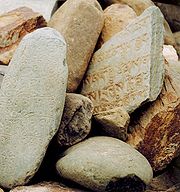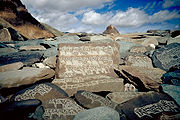
Mani stone
Encyclopedia

Mantra
A mantra is a sound, syllable, word, or group of words that is considered capable of "creating transformation"...
of Avalokiteshvara (Om mani padme hum
Om mani padme hum
is the six syllabled mantra particularly associated with the four-armed Shadakshari form of Avalokiteshvara , the bodhisattva of compassion...
, hence the name "Mani stone"), as a form of prayer
Prayer
Prayer is a form of religious practice that seeks to activate a volitional rapport to a deity through deliberate practice. Prayer may be either individual or communal and take place in public or in private. It may involve the use of words or song. When language is used, prayer may take the form of...
in Tibetan Buddhism
Tibetan Buddhism
Tibetan Buddhism is the body of Buddhist religious doctrine and institutions characteristic of Tibet and certain regions of the Himalayas, including northern Nepal, Bhutan, and India . It is the state religion of Bhutan...
. The term Mani stone may also be used in a loose sense to refer to stones on which any mantra or devotional designs (such as ashtamangala
Ashtamangala
Ashtamangala or Zhaxi Daggyai are a sacred suite of Eight Auspicious Signs endemic to a number of Dharmic Traditions such as Hinduism, Jainism, and Buddhism. The symbols or 'symbolic attributes' are yidam and teaching tools...
) are inscribed. Mani stones are intentionally placed along the roadsides and rivers or placed together to form mounds or cairn
Cairn
Cairn is a term used mainly in the English-speaking world for a man-made pile of stones. It comes from the or . Cairns are found all over the world in uplands, on moorland, on mountaintops, near waterways and on sea cliffs, and also in barren desert and tundra areas...
s or sometimes long walls, as an offering to spirits of place or genius loci
Genius loci
In classical Roman religion a genius loci was the protective spirit of a place. It was often depicted in religious iconography as a figure holding a Cornucopia, patera and/or a snake. There are many Roman altars found in Western Europe dedicated in whole or in part to the particular Genius Loci...
. Creating and carving mani stones as devotional or intentional process art
Process art
Process art is an artistic movement as well as a creative sentiment and world view where the end product of art and craft, the objet d’art, is not the principal focus. The 'process' in process art refers to the process of the formation of art: the gathering, sorting, collating, associating, and...
is a traditional sadhana
Sadhana
Sādhanā literally "a means of accomplishing something" is ego-transcending spiritual practice. It includes a variety of disciplines in Hindu, Sikh , Buddhist and Muslim traditions that are followed in order to achieve various spiritual or ritual objectives.The historian N...
of piety to yidam
Yidam
In Vajrayana Buddhism, an Ishta-deva or Ishta-devata is a fully enlightened being who is the focus of personal meditation, during a retreat or for life. The term is often translated into English as tutelary deity, meditation deity, or meditational deity...
. Mani stones are a form of devotional cintamani
Cintamani
Cintamani also spelled as Chintamani is a wish-fulfilling jewel within both Hindu and Buddhist traditions, equivalent to the philosopher's stone in Western alchemy....
.

Mani walls
Along the paths of regions under the influence of Tibetan BuddhismTibetan Buddhism
Tibetan Buddhism is the body of Buddhist religious doctrine and institutions characteristic of Tibet and certain regions of the Himalayas, including northern Nepal, Bhutan, and India . It is the state religion of Bhutan...
the traveller is often confronted with Mani walls. These stone structures are a compilation intricately carved stone tablets, most with the inscription "Om Mani Padme Hum
Om mani padme hum
is the six syllabled mantra particularly associated with the four-armed Shadakshari form of Avalokiteshvara , the bodhisattva of compassion...
" which loosely translates to "Hail to the jewel in the lotus". These walls should be passed or circumvented from the left side, the clockwise direction in which the earth and the universe revolve, according to Buddhist doctrine.
They are sometimes close to a temple or chorten, sometimes completely isolated and range from a few metres to a kilometre long and one to two metres high. They are built of rubble and sand and faced with mani stones engraved in the elegant Tibetan script.

See also
- Om mani padme humOm mani padme humis the six syllabled mantra particularly associated with the four-armed Shadakshari form of Avalokiteshvara , the bodhisattva of compassion...
- Stele of SulaimanStele of SulaimanThe Stele of Sulaiman is a Yuan Dynasty stele that was erected in 1348 to commemorate the benefactors and donors to a Buddhist temple at the Mogao Caves southeast of Dunhuang in Gansu, China. The principal benefactor is named as Sulaiman , Prince of Xining...
, 1348 stele with Om mani padme hum inscribed in six scripts - Yongning Temple SteleYongning Temple SteleThe Yongning Temple Stele is a Ming Dynasty stele with a trilingual inscription that was erected in 1413 to commemorate the founding of the Yongning Temple in the Nurgan outpost, near the mouth of the Amur River, by the eunuch Yishiha. The location of the temple is the village of Tyr near...
, 1413 stele with Om mani padme hum inscribed in four scripts

